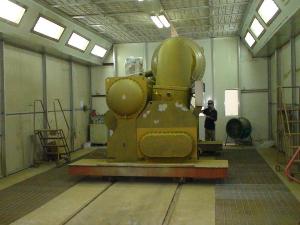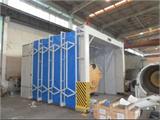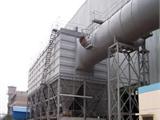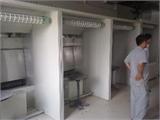Spray painting drying room soso wiki
Abstract of Spray-Bake Paint Room
The spray-bake paint room is designed by our company, drawing on the wisdom of predecessors and combining with our own innovative ideas. It integrates a spray booth and a drying room (bake booth) into one unified system.
Contents: 123456...
The spray-bake paint room operates using top-down air delivery and bottom exhaust. During the spraying process, both the supply fan and exhaust fan start simultaneously (if additional heating is needed in winter, the heating system also starts).
Fresh outdoor air enters through the intake filter for primary purification before reaching the heating and air supply unit. The processed airflow is then delivered by the supply fan to the static pressure chamber at the top of the spray booth. The filtration cotton at the bottom of the static pressure chamber equalizes the airflow and blocks solid dust particles. After filtration, the airflow enters the spray booth at a uniform speed, forming a gentle downward airflow around the workpiece and operator, preventing overspray from dispersing and ensuring operator safety. The average indoor airspeed without load is 0.3-0.5 m/s.
Under orderly airflow, the air containing overspray passes through a lightweight grille into the exhaust trench. Most of the overspray settles on deflection plates due to inertia when the airflow suddenly changes direction below the trench grille. Remaining fine particles are filtered by the paint mist filter cotton beneath the deflection plates. The purified airflow is discharged outdoors via explosion-proof exhaust fans. Paint mist purification efficiency is ≥95%.
During spraying, external air passes through a primary filter net before being delivered by fans to the roof, then undergoes secondary filtration through the top filter net before entering the room. Air within the room descends fully at a speed ≥0.3m/s, carrying paint mist particles directly through the bottom filtration device and out through the exhaust port. This continuous cycle maintains indoor air cleanliness at over 98%, while the pressurized air prevents dust from entering and contaminating the workpiece surface, ensuring maximum paint quality.
The equipment mainly consists of the chamber body, air supply and exhaust system, air purification system, lighting devices, heating devices, exhaust gas treatment system, three-dimensional workbench, electric flat car, electric large gate, and electrical control system. This spray-bake chamber serves dual purposes - spraying and baking.
Key Features:
- Large-scale spray-bake chamber
- Chamber body made from welded square tubes 80x80x5mm, covered with 0.5mm thick EPS sandwich panels with tongue-and-groove joints, thickness δ75mm
- No skeleton structure to reduce heat transfer
- Assembled on-site into a single unit
- Decorative and sealing corner designs inside and outside
- Sealed with sealant to ensure no air leakage
- Two parallel standard steel tracks laid on the floor surface level with the ground for electric flat cars
- Equipped with combustible gas alarm and emergency lighting systems inside the chamber
- Strict safety regulations regarding standing near safety doors and storage of paint materials
- Three return air trenches under the chamber floor with movable steel grilles, load capacity >300kg/㎡
- Lightweight steel structure design for stability and safety
- Composite insulation panels for sealing, aesthetically pleasing and quick construction
- Configurable three-dimensional workbench for large workpieces
- Complies with labor safety and health standards
- Exhaust emissions meet national environmental protection standards
- Safety measures installed: exhaust concentration alarm system activates automatically if dangerous levels are reached
- Energy-efficient explosion-proof lighting with long lifespan and uniform illumination
- Heat exchanger made from high-quality stainless steel, featuring large heat exchange area, high efficiency, energy saving, safety and reliability
- Automatic control system with functions like constant temperature baking and automatic shutdown
- Insulated fans with large airflow and low noise for uniform airflow in the work area
- Various heating options: electric, steam, fuel oil, natural gas
- Main materials use composite insulation panels with galvanized steel outer layers and fire-retardant insulation material
- Advantages: lightweight, novel design, good appearance
- Excellent strength, stiffness, stability, impact resistance, earthquake resistance, corrosion resistance
- Quick construction, waterproof, long service life
The chamber top features a static pressure chamber for uniform airflow. Italian imported filtration cotton is laid at the bottom of the static pressure chamber to ensure clean air entering the chamber and prevent product contamination.
An electrically operated sliding gate is set at one end of the chamber for easy access of workpieces.
A safety door is set on the side wall for personnel access, equipped with adjustable pressure locks and opening/closing devices. In case of accidents, it can automatically release pressure and allow safe evacuation of personnel.
A paint mist filtration layer is laid beneath the grates, easy to replace, with high filtration efficiency and long service life.
Tracks are set close to both sides inside the chamber for placing the three-dimensional workbench, convenient for operators.
Definition: A spray booth is essentially a room where objects are sprayed with paint after being filtered. Now commonly referred to as a spray-bake booth.
Traditional open-air spraying methods have several drawbacks for large objects:
- Mixing airborne dust with paint, reducing quality
- Uncertain paint wastage
- Dirty working environment
- Health risks for workers inhaling paint fumes
This led to the development of early spray booths - extraction type spray booths, first appearing in Chengdu in the 1990s.
Types:
1. Based on airflow direction:
- Crossflow spray booth: Air flows from one end to another. Low cost, easy installation but poor working environment.
- Side downflow spray booth: Air enters through ceiling filters and exits through side walls. Mid-range price, better spray results and working conditions.
- Full downflow spray booth: Latest technology. Air enters through the ceiling and exits through floor trenches or basements. Cleanest spray process but high cost and space requirements.
2. Based on heating method:
- Diesel, electric, steam, infrared, waste oil heated spray booths
3. Based on paint mist treatment:
- Dry and wet (water treatment) spray booths
Maintenance tips:
- Regularly check and replace filters
- Use multi-layer filters instead of filter cloths for better air quality
- Use infrared lamps to reduce drying time
- Use water curtains for more environmentally friendly paint mist removal
Key points for extraction type spray booths:
1. Ventilation
2. Filtration of small particles
3. Exhaust of waste air and intake of fresh air
New developments include full-pressure spray booths widely used in China's furniture industry, utilizing directional pressure for more precise spraying. These incorporate advanced features like infrared lamps (hence also called bake booths) and water curtains for improved environmental performance.
Market overview:
With the growth of China's automotive market, there's increasing demand for various types of spray booths, from large custom models to high-quality specialized bake booths. Manufacturers are focusing more on improving all aspects of their products.
Structure and principle:
The entire spray-bake booth uses an assembled structure, with insulated spray-painted wall panels offering good sealing and thermal insulation. Aluminum-framed doors with observation windows allow monitoring of internal activities. High-quality stainless steel heat exchangers provide efficient heat transfer. Imported low-noise, high-volume fans ensure perfect spray results.
Functions provided:
1. Clean working environment
2. Effective collection of paint mist
Configurations vary based on workpiece size, shape, weight and production requirements, including open/closed types, continuous/intermittent operation, rotating/fixed workpieces, single/double side spraying. New developments include oil curtain and bottom spray booths.
Structural components should include:
- Air supply and filtration system
- Workpiece hanging (conveyance, rotation) device
- Water curtain system
- Washing system
- Exhaust system
- Water tank
- Lighting devices
- Chamber body
Paint mist recovery involves two parts:
1. Paint mist collides with water curtain, partially dissolving into water and settling in tank
2. Undissolved paint mist enters washing chamber through gaps below water curtain, mixing with atomized water spray for separation and settling
Regular maintenance includes:
- Daily cleaning of walls, glass and base
- Weekly cleaning of intake filters and checking exhaust filters
- Replacing floor filters every 150 hours
- Replacing intake filters every 300 hours
- Monthly cleaning of water tanks and diesel filters
- Quarterly inspection of motors and bearings
- Semi-annual cleaning and re-spraying of protective membranes
- Annual cleaning of heat exchangers and replacing top filters
Proper selection and maintenance of spray booths not only ensures high-quality painting but also provides a safe, healthy, bright and comfortable working environment for painters. Prices range from 20,000-60,000 RMB for mid-range models to 150,000-500,000 RMB for large models, with various functions available.
Key factors when selecting a spray booth:
1. Brightness - should reach 800-1000 lux, using D65-like light sources, with matte white walls
2. Airflow rate
3. Filtration effectiveness - depends on top filter model
4. Wall sealing
5. Positive pressure maintenance
6. Heating system sealing
7. Temperature rise speed - should reach 60°C from 20°C in 10-15 minutes
Usage precautions:
1. Check air pressure and filter cleanliness before spraying
2. Ensure air compressor and oil-water separator are functioning properly
3. Store spray guns, hoses and mixing cups in clean areas
4. Complete all pre-spraying processes outside the booth
5. Only perform spraying and baking inside, keeping doors closed except during vehicle entry/exit
6. Wear proper protective clothing and equipment
7. Remove flammable items during baking
8. Restrict access to authorized personnel only
Regular maintenance helps avoid common issues like dust accumulation and poor painting quality, ensuring optimal performance and safety.




